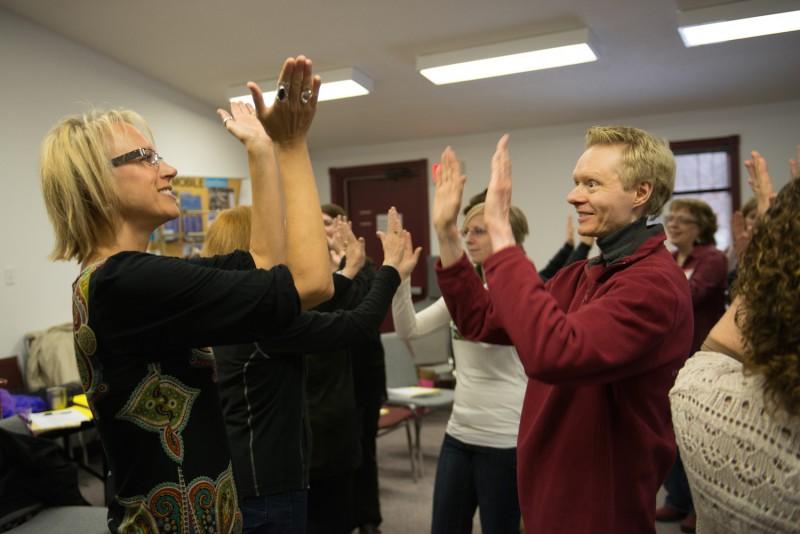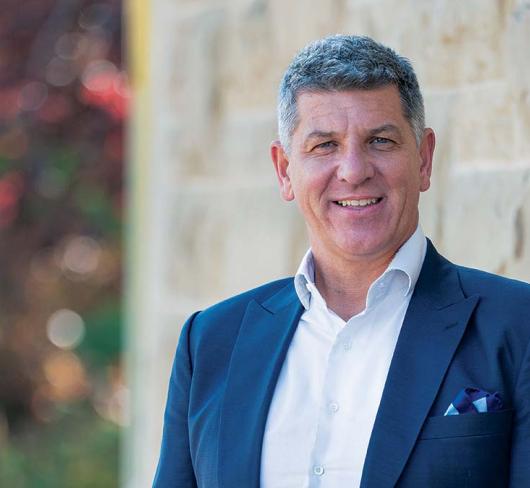
The Lost Art of Play
If adult learning is child’s play, then the teachers gathered on this cold Saturday morning in March understand what is meant by the expression “Playing is learning and learning is playing.”
Approximately thirty interested educators from ETFO’s Kawartha Pine Ridge Teacher Local have met for breakfast and the second of two active learning sessions dedicated to exploring elements of dance, drama, music and visual arts through rich picture books. This Primary ETFO Arts book club offers an excellent opportunity for teachers to engage in learning more about the arts by moving, singing, playing, laughing, sharing, connecting, listening, collaborating, creating and imagining.
The teachers arrive to find an open, desk-free space with a circle of chairs around the perimeter of the room. “She always begins her work in circles,” says Kim. “Circles are an important way to build community and build relationships. Circles are inclusive, not exclusive. Now my students form a circle every morning too!”
We begin the day in a standing circle with a song:
Hello. How do you do? It’s good to be with you.
Hello. How do you do? It’s good to be with you.
Hello. How do you do? It’s good to be with you.
It’s good to be together here with you!
We form concentric circles as we add movement to our song. The room fills with laughter as we try to figure out how we can repeat a grand chain movement correctly. In between each repetition of this simple greeting, the teachers share the arts experiences they had their students participate in as a result of the learning from the previous Primary ETFO Arts book club session. We are mingling to music.
Leah shares an imaginative advertisement for a particular kind of shoe that she wants to entice the participants to buy that has come out of her class’s reading of Those Shoes by Maribeth Boelts. She walks around the room pointing dramatically at the imagined shoes. The teachers gathered are uplifted by the laughter generated by her improvised creative thinking.
Colleen shares dance phrases that her students created after reading I’m Here. These movement sequences emulate the flight path of the paper airplane in Peter Reynolds’ book. The movement sequences start with a beginning balance shape, use a variety of locomotor movements along a pathway and end with another balance shape.
After a reading of Ish, another book by Peter Reynolds, Tracy shares some stunning visual artworks that are Mondrian-ish. The teachers generate multiple ideas about doing “ish” artwork based upon many artists (Van Gogh-ish, Picasso-ish, Henry Moore-ish).
Learning About the Arts through Play
We continue in a seated circle as we create a rainstorm using body percussion. This is a wonderful minds-on activity. When we open the wordless picture book Chalk, by Bill Thomson, we realize the rainstorm is really happening. In pairs, we create soundscapes conveyed by one of the illustrations in the book Chalk using only vocal, found and/or body sounds. You can hear a pin drop as we retell the entire story using these creative soundscapes. It is magical.
As we interpret chalk-drawn movement maps such as those shown in Primary ETFO Arts, we are able to demonstrate the difference between locomotor and non-locomotor movements when we share our dances with the whole group. With the addition of some colourful scarves, this simple activity has a powerful effect upon the audience.
Then, each member of the group chooses a character from the book. We collaboratively create a whole group tableau where each teacher is in role as one of the characters in Chalk. We participate in a thought-tracking experience where, when tapped on the shoulder, each individual says aloud what that character might say. Chalk comes alive. This wordless picture book becomes poetic. Despite the cold outside, we feel warm and safe inside.
Be the Dancer, Dramatist, Musician and Artist
Along with fostering engagement, we learn to think creatively and critically when we actively engage and play in the arts. We know that we learn best by doing. We need opportunities to be the dancer, dramatist, musician and artist. We need time and opportunities to explore the arts, making decisions about the different elements. For example, if we are composing music for an animal, we need to decide whether the music should be loud or soft, fast or slow, and high or low. As visual artists, we need to make choices about whether our lines should be jagged, curved, broken, dashed, spiral, straight, wavy or zigzag when we are sketching. Through exploration of the elements, we refine our abilities to see, think and wonder in all areas of the arts.
When we are being creative, we are thinking at the highest level. This is why creativity and critical thinking are skills that we want to foster in teaching and learning. Creativity and critical thinking are fostered through play.
If we want the classes we teach to be engaging for our students, then we must be fully engaged in the learning. The teachers who are involved in the Primary ETFO Arts book club are. One teacher explains, “Because I was actively engaged in the arts activities, I felt so much more qualified and inspired to share this learning with my students.”
In Arts Education for the Development of the Whole Child, Dr. Rena Upitis affirms this notion: “If the child is to feel the art alive within themselves, so must the teacher. Such direct arts experiences, if they bring life and joy to the teacher, are also likely to find a place in the classroom.”
Why Is Play Important?
In Play: How It Shapes the Brain, Opens the Imagination, and Invigorates the Soul, Stuart Brown illustrates that our ability to play throughout life is the single most important factor in determining our success and happiness.
Play is a lost art. Play creates opportunities to learn from experience. We need the experiences of moving, singing and playing the beat before we can know what “beat” is. We need the experiences of mirroring and shadowing before we can create a movement using a choreographic form known as flocking. These playful experiences precede cognition.
Play engages people socially and creates an atmosphere of trust. Play builds confidence, motivates learners, promotes mental and physical well-being, releases stress, encourages curiosity and exploration, and makes learning fun. According to Stuart Brown, in his TED Talk Play Is More Than Fun, the opposite of play is not work; it’s depression.
Play is not just essential for children. It is essential for all ages. Play can inspire creativity. It can enhance the ability to solve problems in teaching and learning. It can relieve stress and add so much joy. Play can keep you young. As George Bernard Shaw states: “We don’t stop playing because we grow old; we grow old because we stop playing.”
Modelling the Joy of Learning
As an educator, the ability to stay calm, relaxed and ready to teach (self-regulation) is important because the evidence clearly indicates that if adults are self-regulated, children learn about self-regulation too. It follows that when we are joyful, children are joyful too. Our ability to play and have fun while learning has a tremendous effect upon our students.
We learn when we enjoy ourselves. We construct knowledge through direct experiences, social interactions and reflections. During the Primary ETFO Arts book club sessions we were engaged with each other and this supercharged our learning. A climate of trust was created that built our confidence and motivated us to learn about the arts, which in turn encouraged us to share our learning in our own classes.
Play is an integral part of meaningful work. As Sir Ken Robinson explains in The Element: How Finding Your Passion Changes Everything: “Never underestimate the vital importance of finding early in life, the work that for you is play.” We are so lucky when we are passionate about our work in teaching and learning. This passion in teaching enriches our own learning and the learning of our students.
Inquiry into what constitutes playful learning at school leads us to re-examine our roles as educators. When we inquire about what is engaging and playful for our students, our role changes from teacher to facilitator. We listen more and talk less. We engage in the learning along with our students. We ask what we (and our students) know, what we (and our students) need to know, and we reflect upon what we (and our students) have learned.
Play is important for educators because it transforms us. We become attentive to our teaching. We aspire to actively engage our students. We experience the joy of teaching and learning.
One way to inspire change in your teaching and learning is to integrate and play with the arts. Music can enrich your literacy program. Drama can transform a history lesson into an awesome “I felt I was there building the CPR Railway” experience. Your students can express their understanding of a social justice issue through dance or highlight their awareness of the environment by creating an Andy Goldsworthy-ish work of art.
I extend this invitation to you to learn more about the arts through play! As Picasso says, “Every child is an artist. The problem is how to remain an artist once we grow up!”
Brenda Schepper is a member of the Kawartha Pine Ridge Teacher Local. She is an Arts Resource Teacher, an ETFO book club facilitator and an ETFO Kindergarten AQ facilitator.
